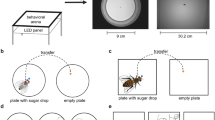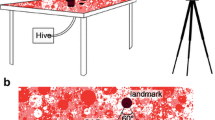Abstract
The availability of food resources changes over time and space, and foraging animals are constantly faced with choices about how to respond when a resource becomes depleted. We hypothesise that flying insects like bees discover new food sources using an optimal Lévy flight searching strategy and odour-mediated anemotaxis, as well as visual cues. To study these searching patterns, foraging honeybees were trained to a scented feeder which was then removed. Two new unrewarding feeders, or ‘targets’, were then positioned up- and downwind of the original location of the training feeder. The subsequent flight patterns of the bees were recorded over several hundred metres using harmonic radar. We show that the flight patterns constitute an optimal Lévy flight searching strategy for the location of the training feeder, a strategy that is also optimal for the location of alternative food sources when patchily distributed. Scented targets that were positioned upwind of the original training feeder were investigated most with the numbers of investigations declining with increasing distance from the original feeder. Scented targets in downwind locations were rarely investigated and unscented targets were largely ignored, despite having the same visual appearance as the rewarding training feeder.




Similar content being viewed by others
References
Baker TC, Vickers NJ (1997) Pheromone-mediated flight in moths. In: Cardé RT, Minks AK (eds) Insect pheromone research: new directions. Chapman and Hall, New York, pp 248–264
Bartumeus F, Peters F, Pueyo S, Marrase C, Catalan J (2003) Helical Levy walks: adjusting searching statistics to resource availability in microzooplankton. Proc Natl Acad Sci 100:12771–12775
Capaldi EA, Smith AD, Osborne JL, Fahrbach SE, Farris SM, Reynolds DR, Edwards AS, Martin A, Robinson GE, Poppy GM, Riley JR (2000) Ontogeny of orientation flight in the honeybee revealed by harmonic radar. Nature 403:537–540
Cardé RT, Mafra-Neto A (1997) Mechanisms of flight of male moths to pheromone. In: Cardé RT, Minks AK (eds) Insect pheromone research: new directions. Chapman and Hall, New York, pp 275–290
Cheng K (2000) How honeybees find a place: lessons from a simple mind. Anim Learn Behav 28:1–15
Dobson HEM (1994) In: Bernays EA (ed) Floral volatiles in insect biology. In: Insect - Plant Interactions Volume V. CRC Press, Boca Raton, FL, pp. 47-81
Edwards AM (2008) Using likelihood to test for Lévy flight search patterns and for general power-law distributions in nature. J Ecol 77:1212–1222
Edwards AM, Phillips RA, Watkins NW, Freeman MP, Murphy EJ, Afanasyev V, Buldyrev SV, da Luz MGE, Raposo EP, Stanley HE, Viswanathan GM (2007) Revisiting Lévy flight search patterns of wandering albatrosses, bumblebees and deer. Nature 449:1044–1048
Giurfa M, Menzel R (1997) Insect visual perception: complex abilities of simple nervous systems. Curr Opin Neurobiol 7:505–513
Giurfa M, Nunez J, Backhaus W (1994) Odour and color information in the foraging choice behaviour of the honeybee. J Comp Physiol 175:773–779
Giurfa M, Vorobyev M, Kevan PG, Menzel R (1996) Detection of coloured stimuli by honeybees: minimum visual angles and receptor specific contrasts. J Comp Physiol 178:699–709
Kennedy JS (1983) Zigzagging and casting as a programme response to wind-borne odor—a review. Physiol Entomol 8:109–120
Kennedy JS (1986) Some current issues in orientation to odour sources. In: Payne TL, Birch MC, Kennedy CEJ (eds) Mechanisms in insect olfaction. Clarendon, Oxford, pp 11–25
Mafra-Neto A, Cardé RT (1994) Fine-scale structure of pheromone plumes modulates upwind orientation of flying moths. Nature 369:142–144
McFrederick QS, Kathilankal JC, Fuentes JD (2008) Air pollution modifies floral scent trails. Atmos Environ 46:2336–2348
Murlis J, Elkinton JS, Cardé RT (1992) Odor plumes and how insects use them. Annu Rev Entomol 37:505–532
Peng CK, Hausdorff JM, Mietus JE, Havlin S, Stanley HE, Goldberger AL (1993) Long-range anticorrelations and non-Gaussian behaviour in the heartbeat. Phys Rev Lett 70:1343–1346
Reynolds AM (2008) Optimal random Lévy-loop searching: new insights into the searching behaviours of central place foragers. Europhysics Letters. 82, article 20001
Reynolds AM (2009) Lévy flight patterns are an emergent property of a bumblebees’ foraging strategy. Behav Ecol Sociobiol . doi:10/1007/s00265-009-0813-7
Reynolds AM, Frye MA (2007) Free-flight odor tracking in Drosophila is consistent with an optimal intermittent scale-free search. PLoS ONE 4:e354
Reynolds AM, Rhodes CJ (2009) The Lévy flight paradigm: random search patterns and mechanisms. Ecology 90:877–887
Reynolds AM, Smith AD, Reynolds DR, Carreck NL, Osborne JL (2007a) Honeybees perform optimal scale-free searching flights when attempting to locate a food source. J Exp Biol 210:3763–3770
Reynolds AM, Smith AD, Menzel R, Greggers U, Reynolds DR, Riley JR (2007b) Displaced honey bees perform optimal scale-free search flights. Ecology 88:1955–1961
Riley JR, Smith AD (2002) Design considerations for an harmonic radar to investigate the flight of insects at low level. Comp Electron Agric 35:151–169
Riley JR, Smith AD, Reynolds DR, Edwards AS, Osborne JL, Williams IH, Carreck NL, Poppy GM (1996) Tracking bees with harmonic radar. Nature 379:29–30
Riley JR, Reynolds DR, Smith AD, Edwards AS, Osborne JL, Williams IH, McCartney HA (1999) Compensation for the wind by foraging bumble bees. Nature 400:126–127
Riley JR, Greggers U, Smith AD, Stach S, Reynolds DR, Stollhoff N, Brandt R, Schaupp F, Menzel R (2003) The automatic pilot of honeybees. Proc Roy Soc Lond B 270:2421–2424
Riley JR, Greggers U, Smith AD, Reynolds DR, Menzel R (2005) The flight paths of honeybees recruited by the waggle dance. Nature 435:205–207
Vickers NJ, Baker TC (1994) Reiterative responses to single strands of odor promote sustained upwind flight and odor source location by moths. Proc Natl Acad Sci 91:5756–5760
Viswanathan GM, Afanasyev V, Buldyrev SV, Murphy EJ, Prince PA, Stanley HE (1996) Lévy flight search patterns of wandering albatrosses. Nature 381:413–415
Viswanathan GM, Buldyrev SV, Havlin S, da Luz MGE, Raposo EP, Stanley HE (1999) Optimizing the success of random searches. Nature 401:911–914
Viswanathan GM, Raposo EP, da Luz MGE (2008) Lévy flights and superdiffusion in the context of biological encounters and random searches. Physics of Life Reviews 5:133–150
Vladusich T, Hemmi JM, Zeil J (2006) Honeybee odometry and scent guidance. J Exp Biol 209:1367–1375
von Frisch K (1967) The dance language and orientation of bees. Harvard University Press, Cambridge
Williams NH, Dodson CH (1972) Selective attraction of male euglossine bees to orchid floral fragrances and its importance in long distance pollen flow. Evolution 26:84–95
Acknowledgements
This work was supported by the Biotechnology and Biological Sciences Research Council (Grant BB/E010695/1). Rothamsted Research receives grant-aided assistance from the Biotechnological and Biological Sciences Research Council of the United Kingdom. Thanks are also due to Shane Hatty, Richard Elsam and Amy McDougall.
Author information
Authors and Affiliations
Corresponding author
Additional information
Communicated by M. Giurfa
Rights and permissions
About this article
Cite this article
Reynolds, A.M., Swain, J.L., Smith, A.D. et al. Honeybees use a Lévy flight search strategy and odour-mediated anemotaxis to relocate food sources. Behav Ecol Sociobiol 64, 115–123 (2009). https://doi.org/10.1007/s00265-009-0826-2
Received:
Revised:
Accepted:
Published:
Issue Date:
DOI: https://doi.org/10.1007/s00265-009-0826-2




